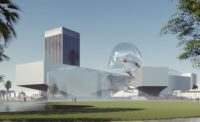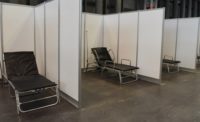On April 6, in the midst of the COVID-19 pandemic, the Los Angeles County Museum of Art (LACMA) began the process of razing four existing buildings on its 20-acre campus to make way for its new flagship by Swiss architect Peter Zumthor. Though the planned structure has long been the focus of inflamed public controversy—and the economic fallout from the coronavirus continues to emerge—the demolition quietly proceeded on schedule, with construction qualifying as an essential activity. (The 1965 Bing Center by William Pereira and Associates was the first to go, to be followed by two other buildings by the same firm and one from 1986 by Hardy Holzman Pfeiffer.)
Meanwhile, an unofficial ideas competition called “LACMA not LackMA,” was underway, seeking enlightened alternatives to the Zumthor scheme. Launched by an activist group dubbed the Citizens Brigade to Save LACMA, the month-long protest-competition was announced on March 13. “We may be flattering ourselves,” says architecture critic (and frequent contributor to RECORD) Joseph Giovannini, co-chair of the Brigade, “but it seems as if [LACMA director] Michael Govan may have accelerated the demolition schedule—to make it a fait accompli—when he knew our competition was coming.” Whether or not the institution actually sped up the process (LACMA has denied any deviation from its longstanding schedule), the ongoing coronavirus crisis has halted construction on some other high-profile cultural projects across the city, including the Renzo Piano–designed Academy Museum of Motion Pictures and MAD’s Lucas Museum of Narrative Art.

Zumthor’s vision for LACMA has existed as an unbuilt scheme since 2009. And while it received a unanimous go-ahead from the Los Angeles County Board of Supervisors about a year ago—and has drawn some (mostly quiet) support within the architectural community—the opposition has not subsided. Resistance mounted as the design morphed over time, prompting the formation of more than one independent citizens’ group to challenge this partially taxpayer-funded institution.
The design, which LACMA has disclosed only schematically, proposes a flat-roofed, quasi-amoeboid, concrete form, housing a single level of glazed gallery space hoisted one story above its site in a public park. Supporting the elevated exhibition level are seven semi-transparent “pavilions,” serving such functions as museum shop and cafés. Although the building’s long, wiggly form did not originally extend beyond the museum’s current site, the planned structure has, for some time, bridged over Wilshire Boulevard, planting a footprint on the other side. In curatorial terms, the design embodies an approach that dissolves categories and boundaries—geographical, chronological, and otherwise—among the encyclopedic museum’s vast collections. At any given time, the new building would show a significantly smaller portion of the holdings previously on view in the old quarters, favoring instead the frequent rotation of artwork, with the promise of satellite venues elsewhere in the county. (The interior space of Zumthor’s proposed structure appears to have diminished through its various iterations —and though LACMA’s web site touts it as “approximately 347,500 square feet,” close, detailed analysis and recalculation by critics place it at 240,000 square feet.)

The price tag, set at $650 million a year ago, has now reportedly risen to $750 million, with speculation that it will reach $1 billion. (The museum, which has secured a $125 million commitment from the county, intends to raise an additional $300 million from bonds and the rest from private donations.) As costs escalate, the design appears to have already scaled back, reducing earlier square footage figures and eliminating such elements as cupola-like skylights in the otherwise unmodulated roof plane.
The project’s opponents have railed against soaring costs and shrinking size (for collections already short on space), and many have specifically denounced the bridging element as an exorbitant and unnecessary expense that creates a visual and experiential disruption of the Wilshire corridor. (Some critics have even likened the road-spanning building to a truck-stop overpass.) Another bone of contention has been the perceived mismanagement and waste of the museum’s land and financial resources, dramatically increasing LACMA’s already-substantial debt burden and squandering, through literal overreach, the remains of its valuable real estate portfolio. Further concerns have arisen about an architectural form that doesn’t accommodate expansion over time—and about Zumthor’s inexperience with large, complex buildings, coupled with his history of massive budget overruns. On top of all that, there’s been profound skepticism about a curatorial stance that dismantles the historic structure of LACMA’s collections, as well as complaints about the lack of transparency in creating this public venue.

Meanwhile, the pandemic and fears of a potential recession have only exacerbated the grievances. While Govan characterizes the venture as an investment in Los Angeles’s future and “an engine of job creation and economic recovery,” a citizens’ organization known as Save LACMA (unrelated to the Citizens Brigade to Save LACMA) has called upon the county to reallocate funds committed to this project to COVID-19 relief efforts.
But well before the coronavirus hit, “LACMA not LackMA” was already in the works, and now the crisis has provided new context for that controversy. It “gives us a chance,” wrote Brigade co-chair Greg Goldin in a Los Angeles Times op-ed, “to pause and ponder the best possible museum that can emerge on the site.” In that spirit, the competition brief calls for solutions that either engage or replace some (or all) of the buildings currently slated for demolition. Jurors Aaron Betsky, Winka Dubbeldam, Joseph Giovannini, Greg Goldin, J. Patrice Marandel, William Pederson, and Barton Phelps received 27 completed entries, all submitted anonymously. Prizes totaling $10,000 will be divided among the finalists. (The funds, Giovannini says, come from a general pot of non-earmarked donations from local citizens.) The Brigade will announce the winners on Monday, April 27 and post an online gallery of the proposals.
“Our hope,” says Giovannini, “is that the quality of these design ideas, their practicality, their feasibility and suitability for the collection—really, all the ways they’re contemporary, challenging, and interesting, yet less expensive, larger, and a comfortable fit on the existing site—will give people pause at a moment when COVID is here, recession is imminent, and the whole project should be reconsidered.”




Post a comment to this article
Report Abusive Comment